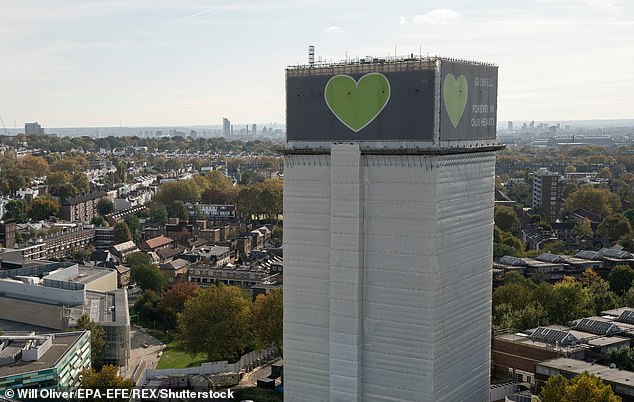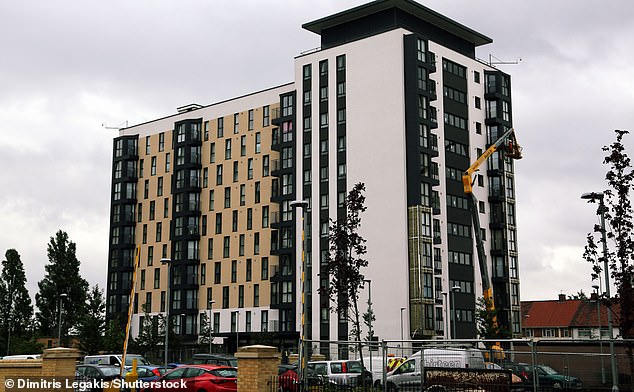
Six of the country’s biggest mortgage lenders have announced that they will lend on cladding-hit flats covered by the Government or developer remediation schemes.
Hundreds of thousands of flats hit by the cladding scandal became unmortgagable after the Grenfell fire, with the properties deemed unsafe and too much of a fire safety risk to lend on.
But the half dozen major lenders have confirmed – via a Government statement – that they will provide mortgages once the cost of the repair works has been signed off.
The lenders are Barclays Bank, HSBC, Lloyds Banking Group, Nationwide, NatWest and Santander.

Since the Grenfell Tower fire in 2017, concerns about cladding have become a national issue
Nationwide confirmed that it would lend, saying: ‘We can confirm that Nationwide will lend to leaseholders living in properties impacted by cladding, where those properties are covered by the Government or developer remediation schemes – subject to our normal lending policy and checks.’
It will come as a huge sense of relief to the hundreds of thousands of affected homeowners.
Many of the leaseholders have waited years to find out if they can sell their homes.
Some leaseholders say it will ‘six or seven years’ between first finding out about the scandal and getting the remediation works completed.
It comes after 48 housebuilders signed up to the Government’s Building Safety Pledge, agreeing to remediate buildings with fire safety defects that are 11 metres and taller.
On July 13, the Housing Secretary published a draft contract to turn this pledge into legally binding commitments.
Leaseholders and other parties now have four weeks to review the contract, with the Government aiming to finalise the terms by August 10 this year.
While affected flat owners welcomed the lenders’ announcement, they said they remain cautious until the ink dries on the contracts.
Campaign group End Our Cladding Scandal said: ‘Positive news. The developer pledges mean nothing until those contracts are signed.
‘The four week deadline is important and must be adhered to. Enough games while innocent leaseholders continue to suffer.’




Many of the affected leaseholders have waited years to find out if they can sell their homes
Some industry insiders suggested that lenders may still need to change their risk policy and lending criteria before being able to lend on such properties.
However, UK Finance – the lending trade body – welcomed the work the Government has undertaken to ensure that leaseholders in properties impacted by cladding and building safety issues will be protected from the costs of remediation.
It said: ‘The introduction of the developer self-remediation scheme, Government’s plans to re-open the Building Safety Fund, and a new remediation scheme for building between 11 and 18 metres will help to remove the financial risks to leaseholders in blocks of flats 11 metres and above.
‘We also recognise that the costs for remediating non-cladding defects is capped in law for qualifying leaseholders.’
Under the new Building Safety Act, leaseholders with non-cladding related issues are protected by a cap on how much they can pay for these costs.
The Act came into force at the end of last month, making it law that building owners – usually property developers or investors – are financially responsible for making dangerous buildings safe – and not the leaseholders of individual flats.
Luay Al-Khatib, of RICS, said: ‘The Building Safety Act has played a critical role in unlocking the lending market regarding properties with cladding and it will create a vehicle to allow valuations on buildings that will be self-remediated by developers, captured under a recognised Government scheme, or where there is evidence of a qualifying lease certificate.
‘A transparent approach to valuing properties with building safety defects is instrumental in underpinning confidence and RICS will continue to safeguard housing market stability for buildings 11 metres and above, and will support valuers to take a consistent valuation approach.’
The Government said in a statement that the six lenders would provide the mortgages on cladding-hit homes – subject to the normal lending policy – where there is fully-funded plan in place to repair the fire defeats on cladding-hit properties.
It said that the move would ‘allow many leaseholders affected by building safety issues to now buy and sell their homes’.
Greg Clark, the Housing Secretary, said: ‘Unlocking the housing market for leaseholders in homes with fire safety issues is critical to helping innocent homeowners caught up in the building safety crisis to move on with their lives.
‘I am delighted that the protections we have put in place for leaseholders as well as our agreement with major property developers have led to commitments from six of the UK’s biggest lenders.
‘This must now be translated into action, and I expect industry, especially lenders and valuers, to work with us quickly to fulfil these promises.’

